May 19, 2025
Weekly Index Highlights, May 19, 2025
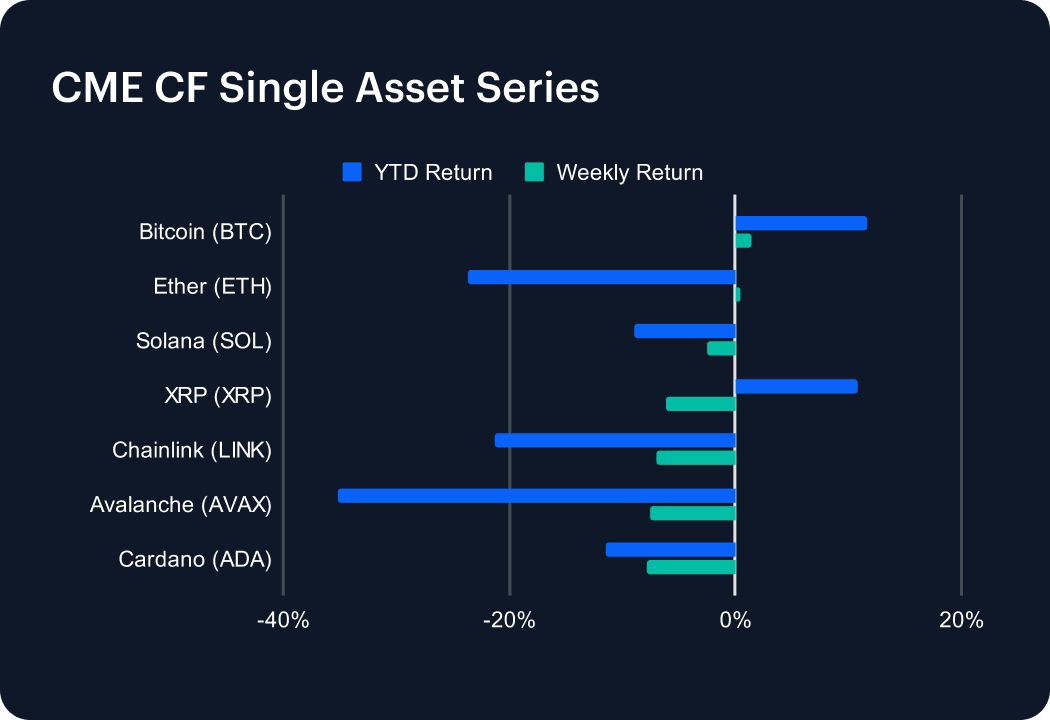
Market Performance Update
The digital asset market stumbled last week, with most major tokens posting declines following recent gains. Avalanche (AVAX) led the losses, falling 7.53% to deepen its year-to-date (YTD) decline to -35.21%. Cardano (ADA) slid 7.84%, while Chainlink (LINK) and Solana (SOL) dropped 7.02% and 2.57%, respectively. XRP (XRP) declined 6.21%, though it still holds a YTD gain of 10.83%. Ether (ETH) managed a modest 0.46% gain, slightly trimming its YTD loss to -23.69%. Bitcoin (BTC) showed continued resilience, rising 1.40% to boost its YTD return to 11.72%. The broad weakness underscores lingering caution among investors, driven by macroeconomic uncertainty and fragile sentiment across risk assets.
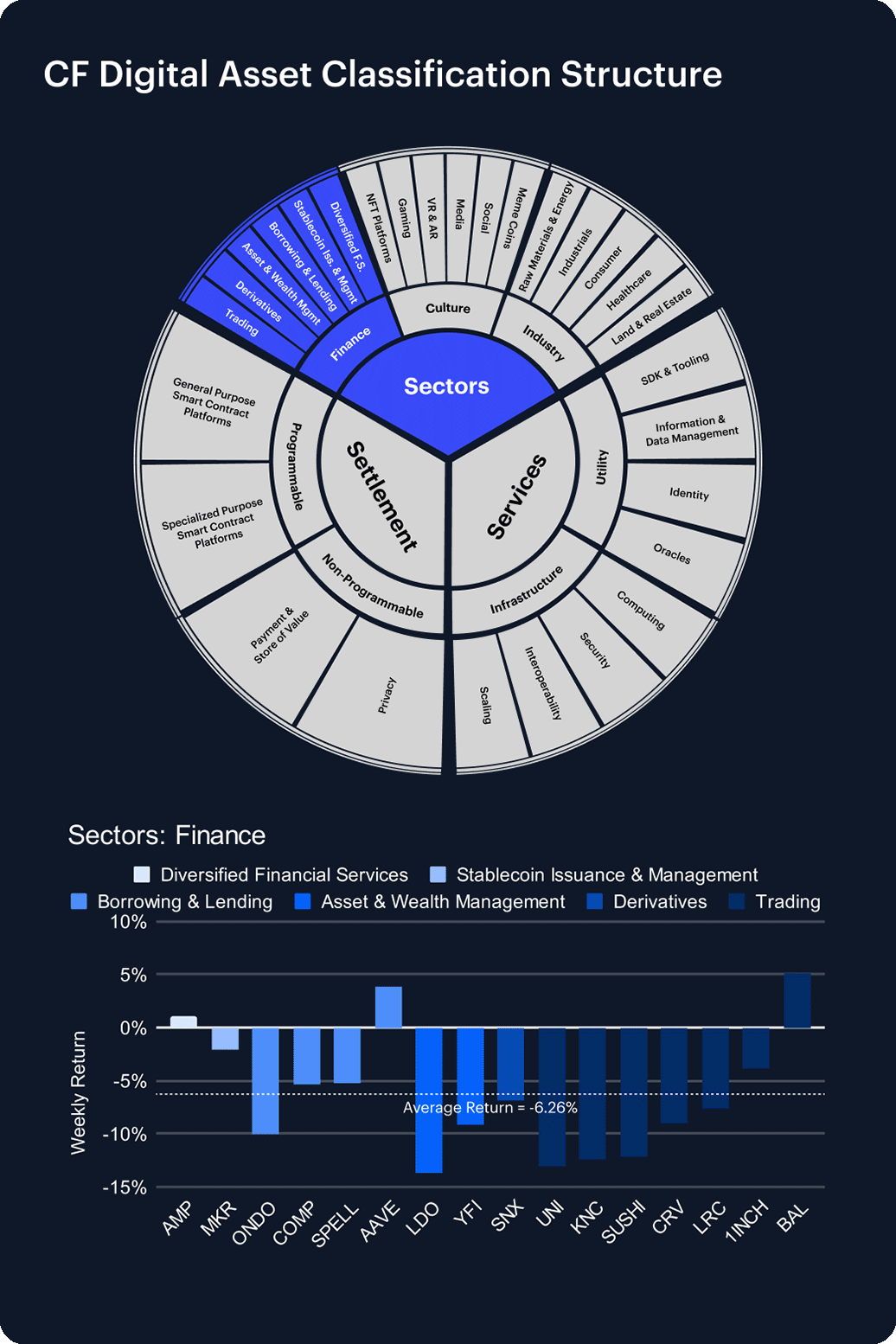
Sector Analysis
Digital assets broadly retreated, with losses across nearly all segments. In Trading, BAL stood out with a 5.13% gain, while UNI (-13.01%) and SUSHI (-12.13%) led the declines. Among Borrowing & Lending protocols, AAVE rose 3.89%, defying the trend, as ONDO (-10.03%) and COMP (-5.34%) dropped. In the Smart Contract Platforms segment, ETH posted a modest 0.46% gain, outperforming sharp pullbacks in NEAR (-11.42%), APT (-12.28%), and FTM (-13.34%). Gaming and Culture tokens fared poorly—AXS (-3.16%), GALA (-12.64%), and SAND (-13.38%) all slumped. Scaling infrastructure was particularly weak, with STRK (-15.47%) and OP (-15.85%) among the worst performers. Only a few assets showed resilience amid the broader risk-off tone.
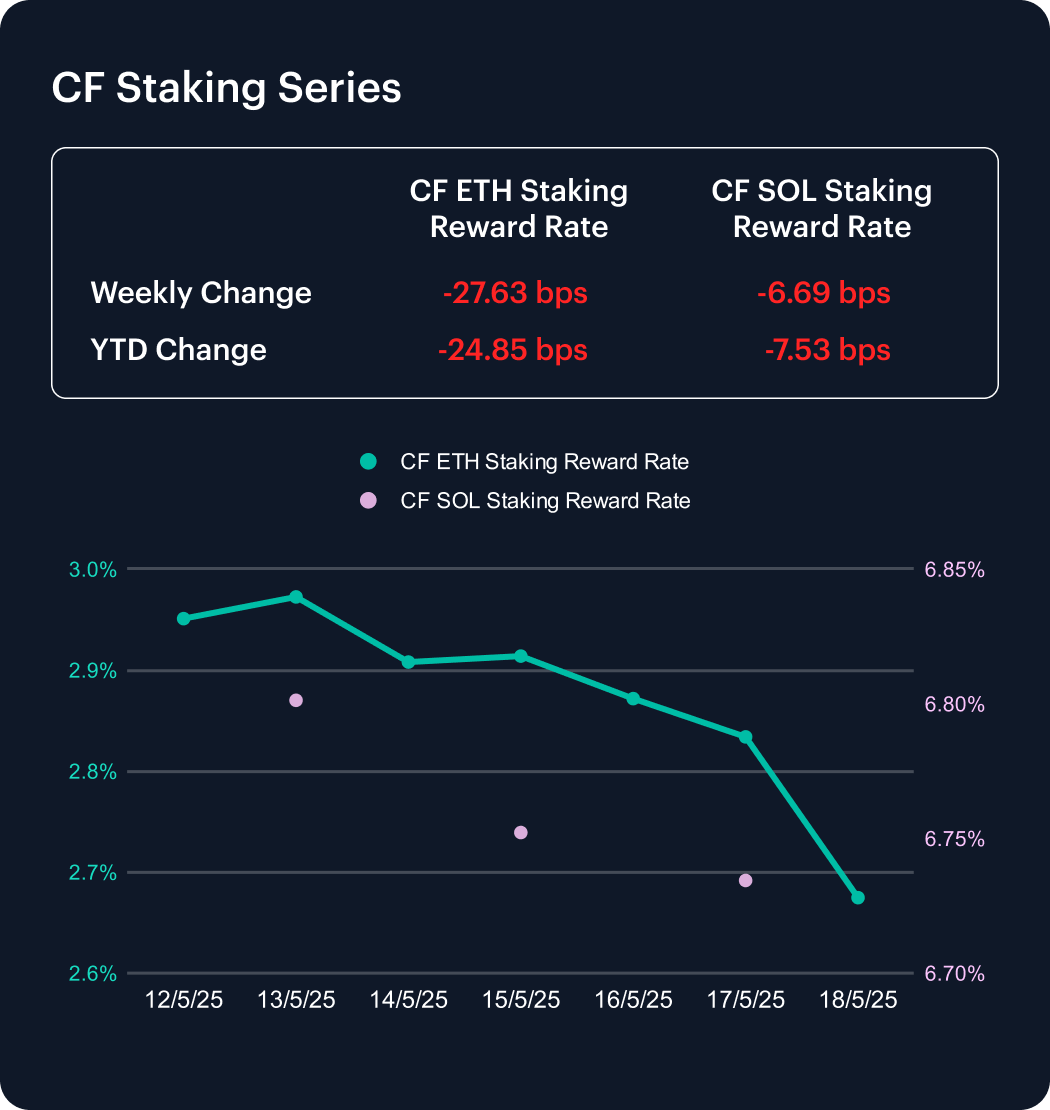
Staking Metrics
The CF Ether Staking Reward Rate Index (ETH_SRR) declined sharply, falling 27.63 basis points to 2.67%, a 9.36% decrease. Year-to-date, ETH_SRR is down 24.85 bps from 2.92%, reflecting an 8.50% decrease and signaling sustained pressure on Ethereum staking yields.
Meanwhile, the CF SOL Staking Reward Rate Index (SOL_SRR) edged down 6.69 bps to 6.73%, marking a 0.98% weekly decline. With a year-to-date drop of 7.53 bps, or 1.11%, Solana’s staking returns have also softened. As both networks see reward compression, the narrowing gap suggests a more uniform re-pricing of yield across major proof-of-stake chains.
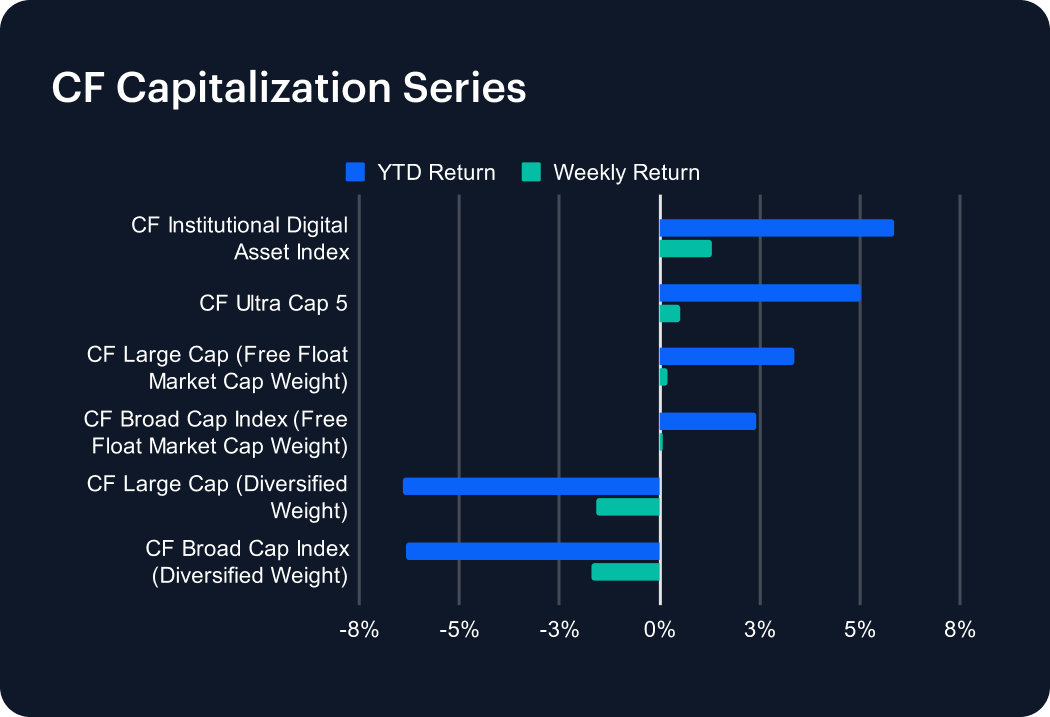
Market Cap Index Performance
The CF Capitalization Series saw mixed performance, as gains in free-float benchmarks contrasted with declines in diversified-weighted indices. The CF Institutional Digital Asset Index led with a 1.29% weekly gain, pushing its year-to-date (YTD) return to 5.85%. The CF Ultra Cap 5 rose 0.50%, bringing its YTD return to 5.03%. Free-float market cap-weighted indices posted modest gains, with the CF Broad Cap Index up 0.07% and the CF Large Cap advancing 0.20%, lifting their YTD returns to 2.42% and 3.38%, respectively. In contrast, diversified-weighted indices declined, as the CF Broad Cap and CF Large Cap fell 1.69% and 1.60%, deepening their YTD losses to -6.32% and -6.40%. The divergence reflects cautious investor rotation into Bitcoin and Ether.

Classification Series Analysis
The CF Classification Series Indices declined, underperforming broader benchmarks as thematic segments faced renewed selling pressure. The CF Digital Culture Composite Index led the losses, falling 6.64% to deepen its year-to-date (YTD) decline to -39.45%. The CF DeFi Composite Index dropped 5.03%, widening its YTD loss to -31.39%. The CF Web 3.0 Smart Contract Platforms Index also retreated, slipping 4.65% and bringing its YTD return to -19.98%. The sharp pullback reflects persistent risk aversion toward speculative sectors, as investors rotate out of high-beta exposures amid ongoing macro uncertainty. Despite previous signs of stabilization, this week’s performance highlights the fragility of sentiment and the continued impact of volatility on structurally weaker parts of the digital asset ecosystem.
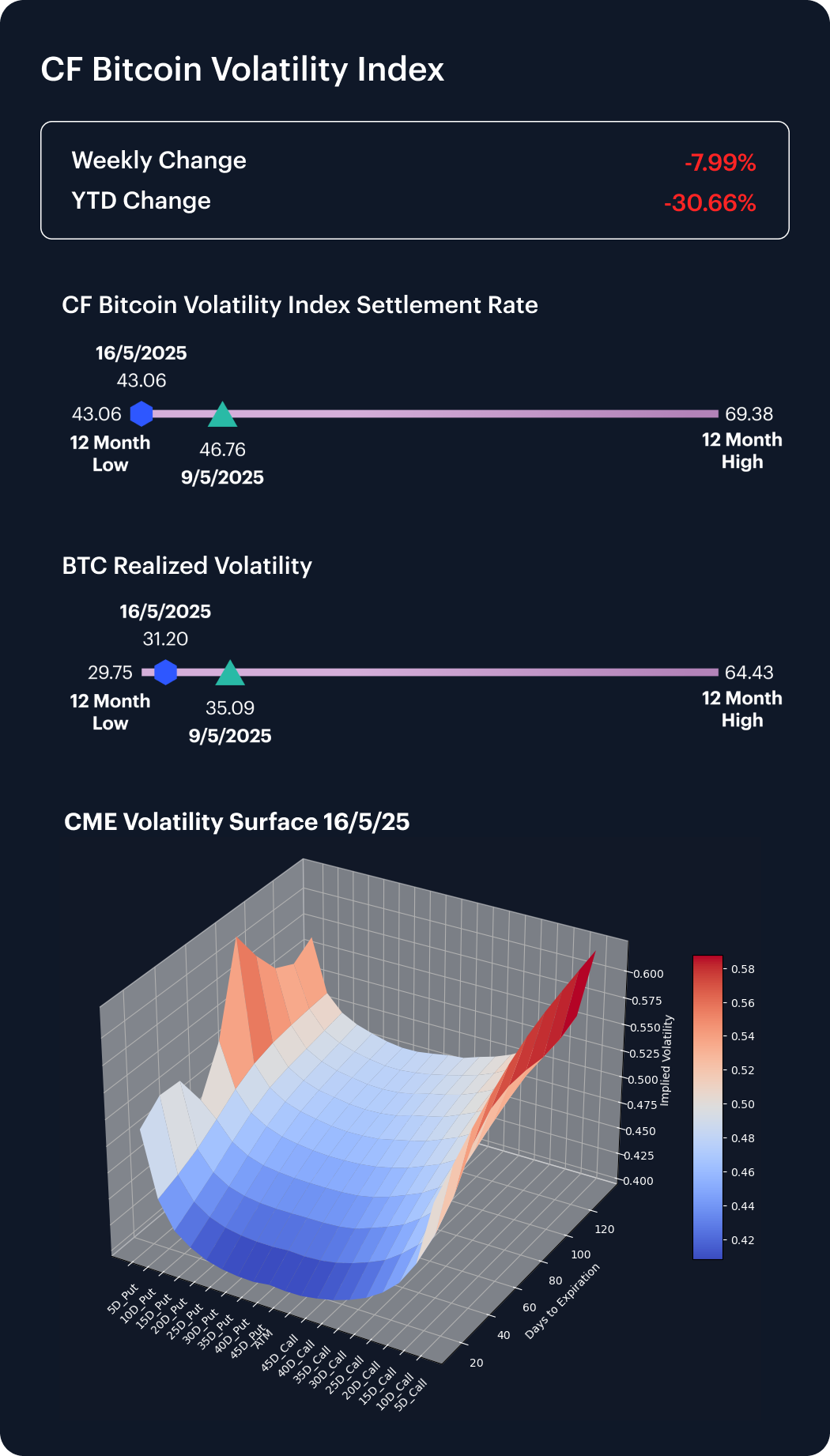
Volatility
The CF Bitcoin Volatility Index Settlement Rate (BVXS) declined notably, falling 3.7 points to 43.06, a 7.91% weekly drop that extends its year-to-date decline to 30.66%. The continued decrease in implied volatility reflects a sustained reduction in demand for hedging and directional positioning, pointing to investor complacency or confidence in near-term price stability. Realized volatility declined sharply, falling from 35.09 to 31.20, indicating subdued price fluctuation.
CME Bitcoin Volatility Surface data continues to show a mild positive skew across 10 to 25 delta options. While overall implied vol levels are soft, elevated pricing in long-dated 5-delta calls suggests that strategies focused on Bitcoin’s asymmetric upside remain in place despite the broader volatility compression.
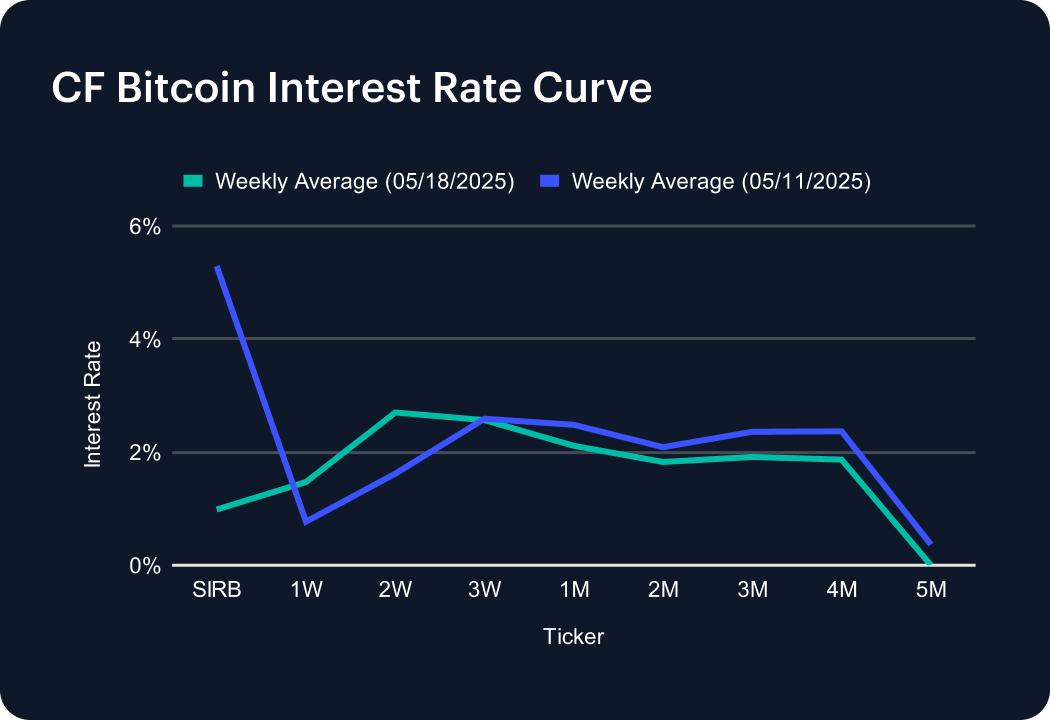
Interest Rate Analysis
The CF Bitcoin Interest Rate Curve declined notably, reversing the prior rebound as funding conditions eased across most tenors. The Short-Term Interest Rate Benchmark (SIRB) dropped sharply to 0.98% from 5.29%, reflecting a significant softening in near-term borrowing demand. While the 1-week and 2-week rates rose to 1.47% and 2.70%, suggesting some front-end leverage activity, mid-curve tenors continued to retreat. The 1-month rate fell to 2.11%, while 2- to 4-month maturities declined modestly. Notably, the 5-month tenor dropped to zero. The curve signals fading speculative positioning beyond the very short term, as traders de-risk amid lower volatility and market consolidation.
The information contained within is for educational and informational purposes ONLY. It is not intended nor should it be considered an invitation or inducement to buy or sell any of the underlying instruments cited including but not limited to cryptoassets, financial instruments or any instruments that reference any index provided by CF Benchmarks Ltd. This communication is not intended to persuade or incite you to buy or sell security or securities noted within. Any commentary provided is the opinion of the author and should not be considered a personalised recommendation. Please contact your financial adviser or professional before making an investment decision.
Note: Some of the underlying instruments cited within this material may be restricted to certain customer categories in certain jurisdictions.
Weekly Index Highlights, December 22, 2025
Crypto's year-end tape remained selective last week, with BTC up 0.9%, while other high-beta majors slipped. The Infrastructure Sub-Category was a major loser in our CF DACS taxonomy, -10.4%, while implied volatility firmed as realized cooled; and our USDT funding rate measure reset above 10%.

CF Benchmarks
Expansion of the CME CF Cryptocurrency Pricing Products Family to include Hedera, Bittensor and Aptos Reference Rates and Real-Time indices
The Administrator announces the addition of Hedera, Bittensor and Aptos Reference Rates and Real-Time indices to the CME CF Cryptocurrency Pricing Products Family.

CF Benchmarks
Cessation of Hedera and Aptos Settlement Prices and Spot Rates within the CF Cryptocurrency Index Family
The Administrator announces the cessation of Hedera and Aptos Settlement Prices and Spot Rates within the CF Cryptocurrency Index Family

CF Benchmarks